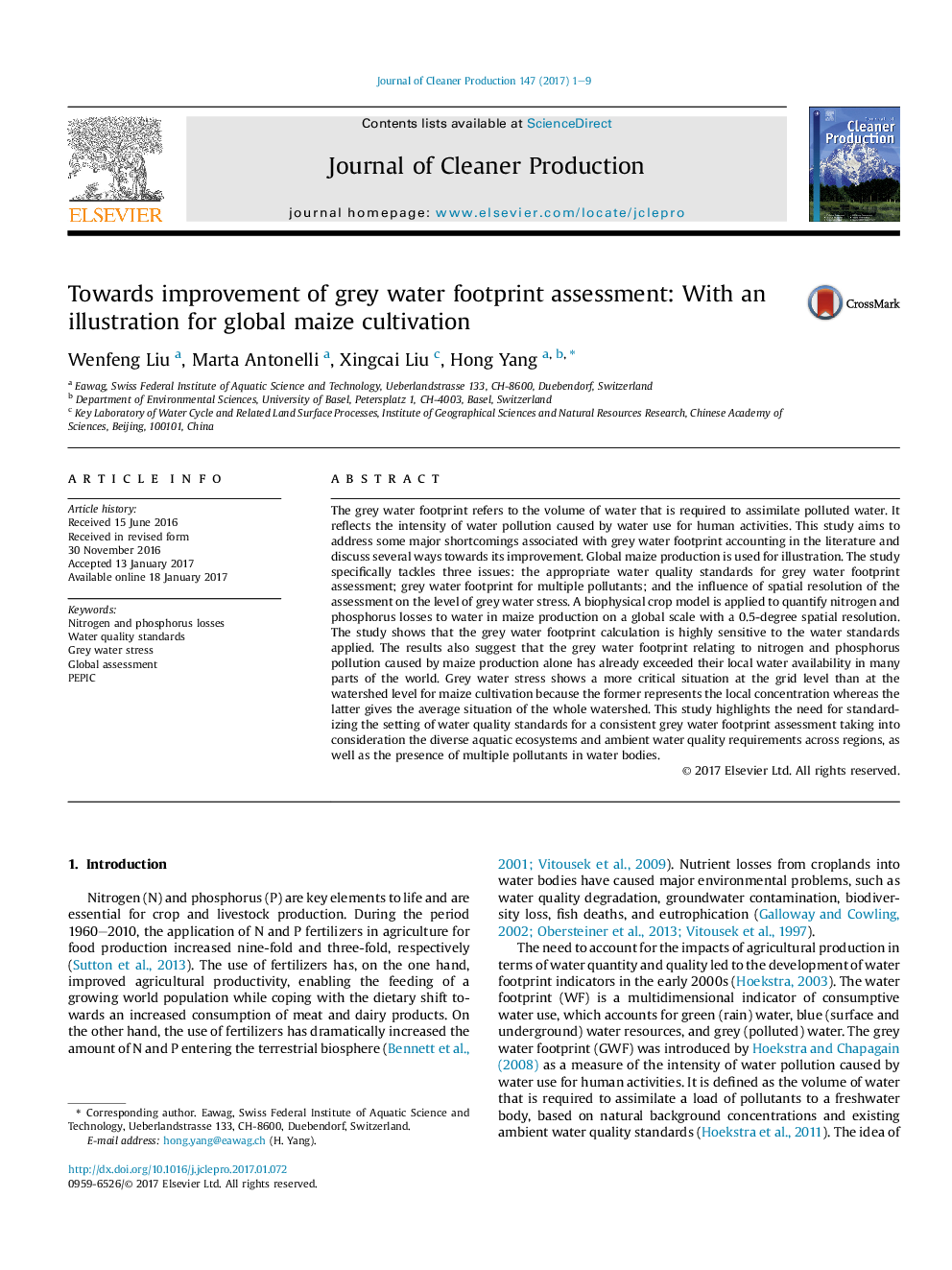| کد مقاله | کد نشریه | سال انتشار | مقاله انگلیسی | نسخه تمام متن |
|---|---|---|---|---|
| 5481452 | 1522106 | 2017 | 9 صفحه PDF | دانلود رایگان |
عنوان انگلیسی مقاله ISI
Towards improvement of grey water footprint assessment: With an illustration for global maize cultivation
ترجمه فارسی عنوان
برای بهبود ارزیابی اثرات آب خاکستری: با یک تصویر برای کشت جهانی ذرت
دانلود مقاله + سفارش ترجمه
دانلود مقاله ISI انگلیسی
رایگان برای ایرانیان
ترجمه چکیده
پدیده آب خاکستری به حجم آب اشاره دارد که برای جذب آب آلوده نیاز است. این نشان دهنده شدت آلودگی آب ناشی از استفاده از آب برای فعالیت های انسانی است. هدف از این مطالعه بررسی برخی از نقایص عمده مرتبط با حسابداری رد پایش آب در ادبیات است و چندین راه برای بهبود آن را مورد بحث قرار می دهد. تولید ذرت جهانی برای نشان دادن استفاده می شود. این مطالعه به طور خاص با سه مسئله مطابقت دارد: استانداردهای کیفیت آب مناسب برای ارزیابی رد پای خاکستری؛ اثر آب خاکستری برای آلاینده های چندگانه؛ و تأثیر تفکیک فضایی ارزیابی بر سطح استرس آب خاکستری. یک مدل محصول بیوفیزیکی برای اندازه گیری تلفات نیتروژن و فسفر به آب در تولید ذرت در مقیاس جهانی با وضوح فضایی 0.5 درجه اعمال می شود. این مطالعه نشان می دهد که محاسبه رد پای خاکستری آب بسیار حساس به استانداردهای آب است. نتایج همچنین نشان می دهد که اثرات آب های خاکستری مربوط به آلودگی نیتروژن و فسفر ناشی از تولید ذرت به تنهایی از بیش از منابع آب محلی در بسیاری از نقاط جهان است. استرس آب خاکستری وضعیت بحرانی بیشتری در سطح شبکه نشان می دهد که در سطح آبریز برای کشت ذرت است؛ زیرا اولین نشان دهنده تمرکز محلی است، در حالی که این وضعیت به طور متوسط وضعیت کل حوزه آبریز را نشان می دهد. این مطالعه نیاز به استاندارد سازی استانداردهای کیفیت آب برای ارزیابی پایدار آب در خاک را با توجه به اکوسیستم های مختلف آبزی و الزامات کیفیت آب محیطی در مناطق و نیز حضور آلاینده های متعدد در آب های آبی نشان می دهد.
موضوعات مرتبط
مهندسی و علوم پایه
مهندسی انرژی
انرژی های تجدید پذیر، توسعه پایدار و محیط زیست
چکیده انگلیسی
The grey water footprint refers to the volume of water that is required to assimilate polluted water. It reflects the intensity of water pollution caused by water use for human activities. This study aims to address some major shortcomings associated with grey water footprint accounting in the literature and discuss several ways towards its improvement. Global maize production is used for illustration. The study specifically tackles three issues: the appropriate water quality standards for grey water footprint assessment; grey water footprint for multiple pollutants; and the influence of spatial resolution of the assessment on the level of grey water stress. A biophysical crop model is applied to quantify nitrogen and phosphorus losses to water in maize production on a global scale with a 0.5-degree spatial resolution. The study shows that the grey water footprint calculation is highly sensitive to the water standards applied. The results also suggest that the grey water footprint relating to nitrogen and phosphorus pollution caused by maize production alone has already exceeded their local water availability in many parts of the world. Grey water stress shows a more critical situation at the grid level than at the watershed level for maize cultivation because the former represents the local concentration whereas the latter gives the average situation of the whole watershed. This study highlights the need for standardizing the setting of water quality standards for a consistent grey water footprint assessment taking into consideration the diverse aquatic ecosystems and ambient water quality requirements across regions, as well as the presence of multiple pollutants in water bodies.
ناشر
Database: Elsevier - ScienceDirect (ساینس دایرکت)
Journal: Journal of Cleaner Production - Volume 147, 20 March 2017, Pages 1-9
Journal: Journal of Cleaner Production - Volume 147, 20 March 2017, Pages 1-9
نویسندگان
Wenfeng Liu, Marta Antonelli, Xingcai Liu, Hong Yang,
